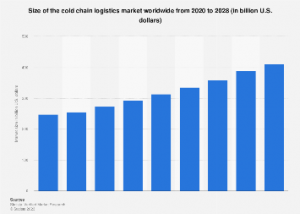The Cold Chain Logistics Market: A Comprehensive Overview
In the ever-evolving landscape of global commerce, the cold chain logistics market plays a pivotal role in ensuring the safe and efficient transport of temperature-sensitive goods. From pharmaceuticals to perishable foods, the cold chain is a critical component of supply chains worldwide. In this article, we will delve into the size and significance of the cold chain logistics market, exploring its current state and future prospects.
The Growth Trajectory of Cold Chain Logistics
The cold chain logistics market has witnessed remarkable growth in recent years, driven by increasing globalization, expanding pharmaceutical and healthcare industries, and the rising demand for perishable goods. The market’s size is influenced by a multitude of factors, including technological advancements, regulatory requirements, and the growing need for specialized transportation solutions.
Global Expansion and Trade Dynamics:
One of the primary drivers of the cold chain logistics market’s expansion is the globalization of trade. As companies extend their reach across borders, the need for efficient and reliable cold chain solutions becomes paramount. The market has responded to this demand by developing sophisticated temperature-controlled transportation and storage systems.
Pharmaceutical and Healthcare Sector Influence:

The pharmaceutical and healthcare industries have emerged as major contributors to the growth of the cold chain logistics market. With the increasing production and distribution of temperature-sensitive drugs and vaccines, the demand for precise temperature control throughout the supply chain has surged. This has led to substantial investments in cold chain infrastructure and technology.
Quantifying the Market: Current Size and Projections
Accurately gauging the size of the market is essential for stakeholders, including manufacturers, logistics providers, and investors. The market size is typically measured by assessing the revenue generated by cold chain logistics services, equipment, and technology. According to recent industry reports, the global cold chain logistics market is estimated to be worth several billion dollars, with a compound annual growth rate (CAGR) that indicates sustained expansion.
Regional Disparities and Opportunities:
The cold chain logistics market exhibits regional variations, influenced by factors such as economic development, infrastructure capabilities, and regulatory frameworks. While developed regions like North America and Europe have well-established cold chain networks, emerging economies in Asia-Pacific and Latin America present significant growth opportunities. The increasing consumer demand for high-quality perishable goods and pharmaceuticals in these regions is a key driver.
Technological Advancements and Market Expansion:
The integration of advanced technologies, including IoT (Internet of Things) sensors, RFID (Radio-Frequency Identification), and data analytics, has propelled the cold chain logistics market forward. These technologies enhance real-time monitoring, improve visibility, and optimize the overall efficiency of the supply chain. As the industry embraces digitization, it opens new avenues for market expansion and innovation.
Challenges and Opportunities in the Cold Chain Logistics Sector
While the cold chain logistics market presents lucrative opportunities, it also faces significant challenges that necessitate strategic solutions. Understanding these challenges is crucial for stakeholders seeking sustainable growth in this dynamic sector.
Infrastructure Gaps and Investment Needs:
One of the primary challenges is the existence of infrastructure gaps, especially in developing regions. Insufficient cold storage facilities, inadequate transportation networks, and a lack of regulatory compliance pose hurdles to seamless cold chain operations. Addressing these gaps requires substantial investments in infrastructure development and technology adoption.
Regulatory Compliance and Stringent Standards:
The market operates in a highly regulated environment due to the sensitivity of the goods being transported. Compliance with stringent quality standards and regulations is non-negotiable. Companies must navigate a complex landscape of international and local regulations to ensure the integrity of the cold chain, adding to operational complexities and costs.
The Future of Cold Chain Logistics: Emerging Trends and Innovations
Looking ahead, the market is poised for continued growth, driven by emerging trends and innovative solutions. Stakeholders who stay ahead of these trends will be better positioned to capitalize on new opportunities and overcome challenges.
Green Cold Chain Practices:
Sustainability is gaining prominence in the sector. Companies are increasingly adopting environmentally friendly practices, such as energy-efficient refrigeration technologies and alternative fuels for transportation. Green initiatives not only align with global sustainability goals but also contribute to cost savings and enhanced brand reputation.

Blockchain Technology for Transparency:
Blockchain technology is making inroads into the cold chain logistics market, offering enhanced transparency and traceability. By providing an immutable and decentralized ledger, blockchain enables stakeholders to track the entire journey of temperature-sensitive goods, ensuring accountability and reducing the risk of spoilage or tampering.
Conclusion
In conclusion, the market is a dynamic and vital component of the global supply chain. Its size and significance continue to expand, fueled by factors such as globalization, industry-specific demands, and technological advancements. As the market navigates challenges and embraces opportunities, stakeholders must stay agile and innovative to thrive in this evolving landscape. The future holds promise, and those who adapt to emerging trends will play a pivotal role in shaping the industry’s trajectory.
